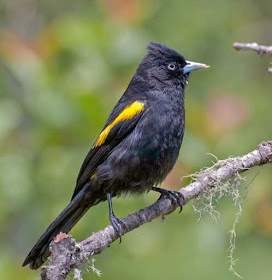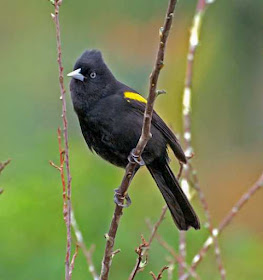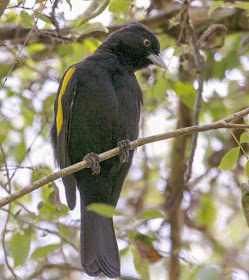Bird World › Black siskin › Golden-winged cacique - Cacicus chrysopterus
The golden-winged cacique (Cacicus chrysopterus) belongs to the family of cowbirds, oropendolas and caciques, the Icteridae.The golden-winged cacique is distributed over Argentina, Paraguay, Uruguay, Bolivia and Brazil in South America. These cacique species have overall black plumage with bright yellow wing patch. These caciques are monotypic species.
Appearance, physical description and identification
The golden-winged cacique (Cacicus chrysopterus) is a medium-sized cacique, measuring 19 to 21 cm in length and weighing 30 to 47 grams. The males are slightly larger.The golden-winged cacique has overall slightly glossy, black plumage. There is a bright yellow patch on the folded wing and the lower rump. The tail is slightly notched. There is a small black crest on the crown.
The bill is conical, sharp and pale gray in color. The short legs and feet are blackish. The irises are blackish. There is a whitish eye-ring. Their call is a varying, low-pitched, musical sound.
 |
| 1.South American bird - Golden-winged cacique - Cacicus chrysopterus Image by Dario Sanches |
 |
| 2.South American bird - Golden-winged cacique - Cacicus chrysopterus Image by Dario Sanches |
 |
| 3.South American bird - Golden-winged cacique - Cacicus chrysopterus Image by Lip Kee Yap |
Origin, geographical range and distribution
The golden-winged cacique is distributed over Argentina, Paraguay, Uruguay, Bolivia and Brazil in South America.Ecosystem and habitat
These golden-winged cacique species have moderate forest dependence. They normally occurs in altitudes between 0 to 2000 meters.The natural ecosystems and habitats of these species include tropical and subtropical dry forests, tropical and subtropical moist lowland forests and tropical and subtropical moist montane forests.
Diet and feeding behavior
The diet of these golden-winged cacique species consists mainly of invertebrates. Insects, beetles, small vertebrates, fruits, berries and nectar are their primary food.Reproduction and breeding habits
The breeding season of these species is from October to December in Argentina. They are monogamous and solitary nesters. Their nest is a long hanging basket. The nest is built by the female.Migration and movement patterns
These cacique species are non-migratory, resident birds. The populations in higher altitudes may descent to lower altitudes in winter months.Post breeding, the juveniles may disperse and establish in new locations within the range. They may make local movements within their range for feeding and breeding.
Golden-winged cacique - Quick Facts
- Scientific name: Cacicus chrysopterus
- Species author: (Vigors, 1825)
- Synonyms/Protonym: Xanthornus Chrysopterus Vigors, 1825
- Family: Icteridae › Passeriformes › Aves › Chordata › Animalia
- Vernacular names: English: Golden-winged cacique, Chinese: 金翅酋长鹂, French: Cassique à épaulettes, German: Goldschulterkassike, Spanish: Cacique aliamarillo, Russian: Золотокрылый чёрный кассик, Japanese: キンバネツリスドリ
- Other names: Golden-winged Cacique
- Distribution: Argentina, Paraguay, Uruguay, Bolivia, Brazil
- Diet and feeding habits: seeds, berries, insects, invertebrates, small vertebrates
- IUCN status listing: Least Concern (LC)
Conservation and survival
The global population size of the golden-winged cacique (Cacicus chrysopterus) has not been quantified. The overall population trend of the species is reported to be stable.In most of its range, this species is reported to be 'fairly common' (Stotz et al. (1996). The generation length is 4.6 years. Its distribution size is about 2,980,000 sq.km.
Ecosystem degradation, ecosystem conversion and trapping of adults and juveniles for pet-trade are the main threats that may endanger the survival of the cacique species.
IUCN and CITES status
The golden-winged cacique (Cacicus chrysopterus) species does not approach the thresholds for being Vulnerable either under the range size criterion, or under the population trend criterion or under the population size criterion.The IUCN (International Union for Conservation of Nature) has categorized and evaluated the species and has listed it as of "Least Concern".
The CITES (Convention on International Trade in Endangered Species of Wild Fauna and Flora) status is ‘Not Evaluated’ for the golden-winged cacique (Cacicus chrysopterus).
1.Golden-winged cacique image source: https://en.wikipedia.org/wiki/File:Cacicus_chrysopterus_-Reserva_Guainumbi,_Sao_Luiz_do_Paraitinga,_Sao_Paulo,_Brasil-8.jpg (cropped)
Image author: Dario Sanches | License: CC BY-SA 2.0 as on 11/28/18
2.Image source: https://commons.wikimedia.org/wiki/File:TECEL%C3%83O_(_Cacicus_chrysopterus_).jpg (cropped)
Image author Dario Sanches | License: CC BY-SA 2.0 as on 11/28/18
3.Image source: https://commons.wikimedia.org/wiki/File:Cacicus_chrysopterus_-Argentina-8.jpg (cropped)
Image author: Lip Kee Yap | License: CC BY-SA 2.0 as on 11/28/18
Website for detailed description and information on distribution, habitat, behavior, feeding and breeding habits, migration and conservation status of beautiful birds with their images.
Updated Nov 28, 2018
Recently updated and current topic in South American birds: Golden-winged cacique - Cacicus chrysopterus with images.
